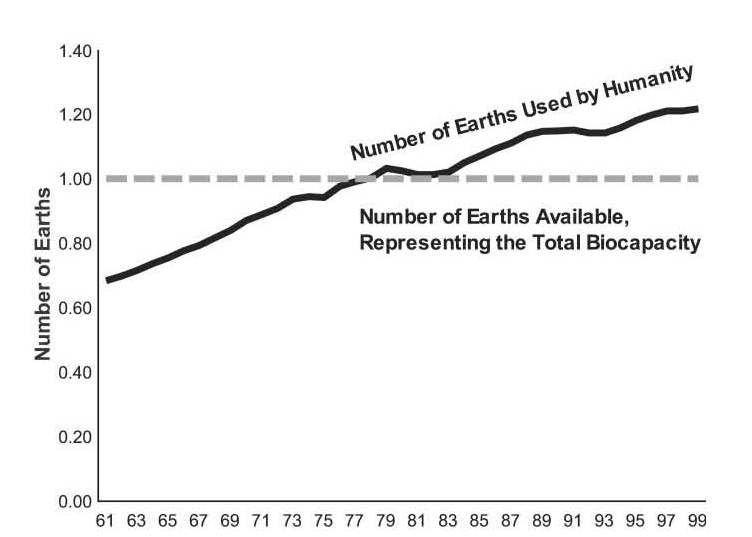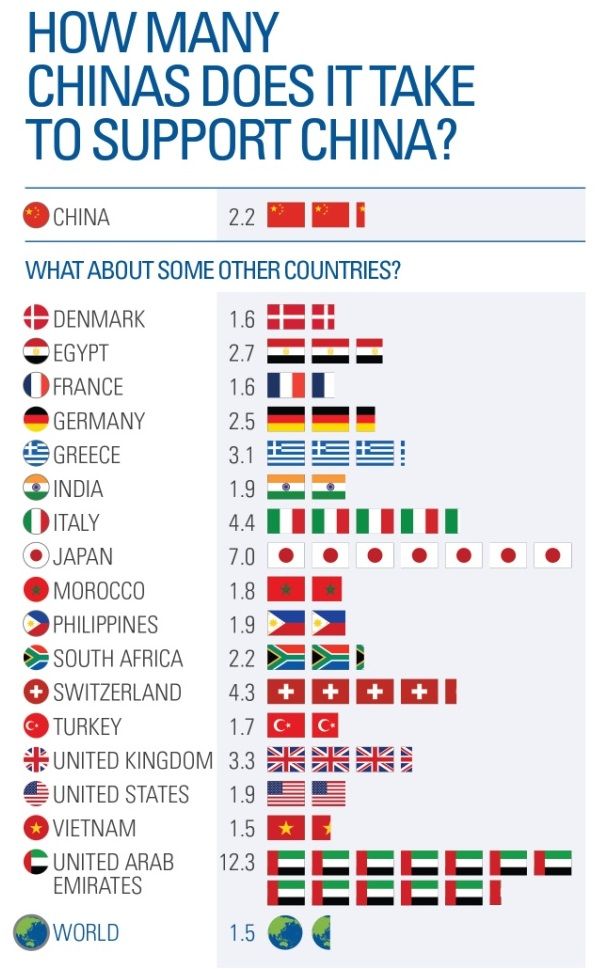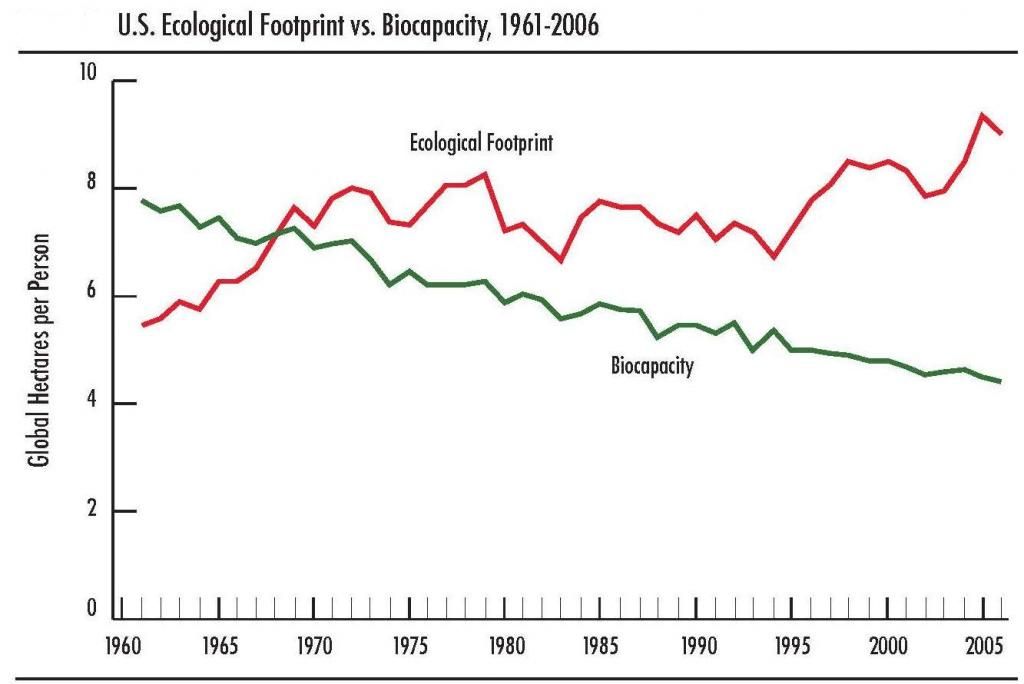Overusing the Planet’s Natural Capital — Earth Overshoot Day 2014
Published on August 19th, 2014
Today, Tuesday, August 19, is Earth Overshoot Day. This is the date humanity’s aggregate Ecological Footprint (EF) exceeds our planet’s annual budget, according to analysts at the Global Footprint Network.
 If humanity’s growing demands were not already in excess of the planet’s ability to yield organic (carbon-based) renewable resources and absorb related wastes, there would be no Earth Overshoot Day…and no destabilizing build-up of carbon dioxide (CO2) in our atmosphere, among other ills. Unfortunately, that is not the case.
If humanity’s growing demands were not already in excess of the planet’s ability to yield organic (carbon-based) renewable resources and absorb related wastes, there would be no Earth Overshoot Day…and no destabilizing build-up of carbon dioxide (CO2) in our atmosphere, among other ills. Unfortunately, that is not the case.
Every year, as a result of humanity’s increasing population and demands on resources, Earth Overshoot Day has crept backward to earlier dates on the calendar. In 2000 it was in early October. Now in 2014, it has shifted all the way back to August 19.
EF is a measure of the area of biologically productive land and sea needed to produce all the organic (carbon-based) resources a given population consumes and to absorb its carbon-based waste, particularly CO2 emitted from tailpipes and smoke stacks. The EF also takes into account technological changes that affect the efficiency with which economies use resources.
Ecological overshoot occurs when overall human demand exceeds the regenerative capacity, or biocapacity, of a natural ecosystem. Overshoot happens on a planetary scale when all 7.2 billion humans’ combined demands exceed what the entire biosphere can renew.
In other words, humanity’s EF exceeds what Earth as a whole can regenerate. The biosphere’s renewable capacity includes the replenishment of resources and the absorption or assimilation of waste, such as CO2 from the combustion of carbon-based fossil fuels (coal, oil, natural gas) in our cars, trucks and power plants.
The Global Footprint Network (GFN) is a think tank headquartered in Oakland, California, with offices in Geneva, Switzerland and Brussels, Belgium. GFN estimates that:
…the level of resources and ecosystem services required to support human activities is just over 1.5 Earths. Overshoot has nearly doubled since 1961. In that time, human demand on resources has gone from being within the means of what nature could support to significantly over budget.

The number of Earths is constant at 1.0, but our ecological footprint now far exceeds 1.0; that is,
we are overtaxing Earth’s biocapacity.
Ecological overshoot is a function of four key factors:
- How much we each consume
- How efficiently products are made
- How many of us there are (population size)
- How much nature is able to produce and regenerate (biocapacity).
Over time, technology and more intensive inputs (such as fertilizers from nonrenewable fossil fuels) have helped humankind to expand biological productivity (e.g., crop harvests), but that expansion has not come close to keeping pace with the rate at which population and resource demand have expanded.
World population and consumption are both increasing exponentially. Higher per capita consumption leaves a smaller slice of the resource pie for everyone. A larger population means finite resources must be divided among more and more people. Due to both factors – consumption as well as population – humanity is simply demanding more than Earth can yield sustainably. This overuse cannot be maintained indefinitely, because we are drawing down “natural capital,” squandering our natural inheritance like a spendthrift adolescent on a reckless binge.
Today, according to the GFN, 86 percent of us live in countries that use more ecological resources than their own ecosystems can regenerate. These “ecological debtor” nations either deplete their own ecological capital or have to import resources from elsewhere – if they can afford to – and many cannot.
Ecological debtors use more resources than they produce. Were residents of the United Arab Emirates (UAE) to consume ecological resources produced solely within the UAE’s borders, the UAE would have to be 12.3 times larger. In other words, the UAE’s Ecological Footprint is 12.3 times larger than its biocapacity.

Similarly, it would take 2.7 Egypts to support the current number of Egyptians. And the United States? We Americans, all 319 million of us, would need a country almost twice as large to live sustainably. If the entire world consumed resources as intensively as Americans do, humanity would need more than four Earths to live within its ecological means. But we have – and all we will ever have – is just one Earth.
The U.S. became an “ecological debtor” nation back in the late 1960s. That’s when our Ecological Footprint surpassed our biocapacity, driving us into ecological debt.
America’s immigration-driven population growth, with no end in sight, is pushing the United States ever deeper into ecological debt. This is short-sighted and environmentally irresponsible and unsustainable.
EF also includes the Carbon Footprint, which is the land area required to sequester CO2 emissions from fossil fuel combustion, cement production and burning down forests. Humanity’s Carbon Footprint is the main driver of climate change.

America’s Widening Gap between our Ecological Footprint and our Biocapacity: a Deepening
Ecological Debt
Nowadays, the Carbon Footprint is more than half of humanity’s total Ecological Footprint. It is also the fastest-growing part of the EF. A century ago the Carbon Footprint was a very small fraction of the overall EF; no longer.
Ecological overshoot occurs in nature, when populations of organisms irrupt to the extent that they far outstrip the ability of their environments or habitats to sustain them. But overshoot is invariably a relatively short-lived phenomenon, because it degrades and depletes environments, slashing their carrying capacity.
What follows overshoot? In nature, populations “collapse” or “crash.” We humans, in spite of our vaunted smarts and technology, are not exempt from ecological constraints.
To avoid the fate that befalls other creatures in ecological overshoot mode, humanity needs to:
- Conserve all renewable and nonrenewable natural resources and use them far more efficiently
- Embark on a crash course of renewable energy (wind, solar, hydro, geothermal, tidal, wave, etc.) development
- Stabilize and then gradually lower human population numbers
- Achieve these without crashing our economies.
There is no time for dawdling, either here in America or globally. As the image above suggests, much of the sand has already slipped through the hourglass.




